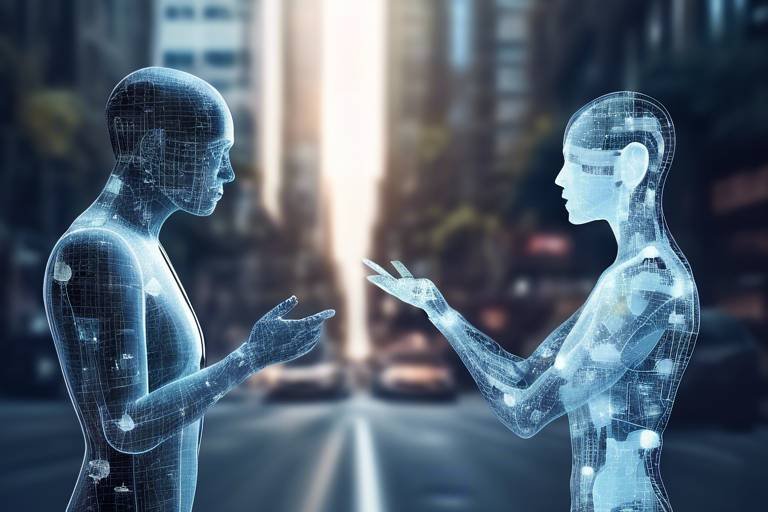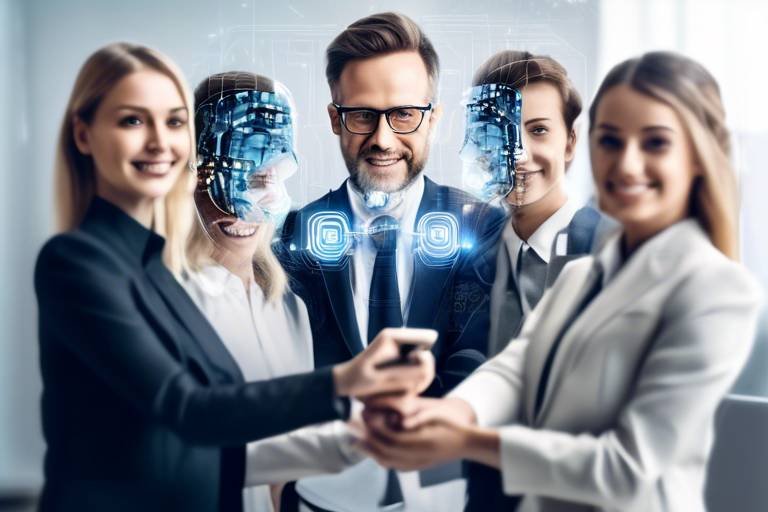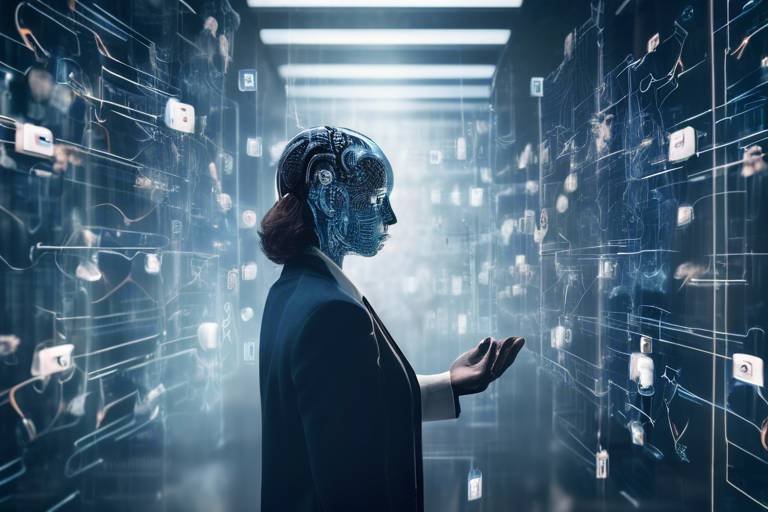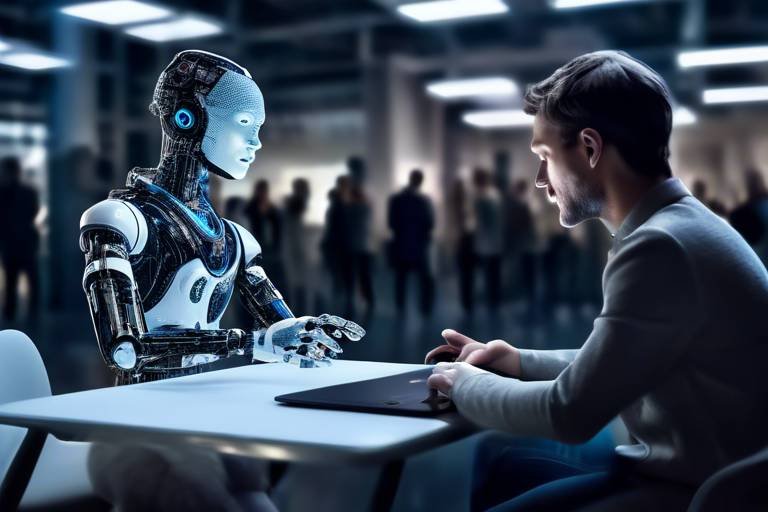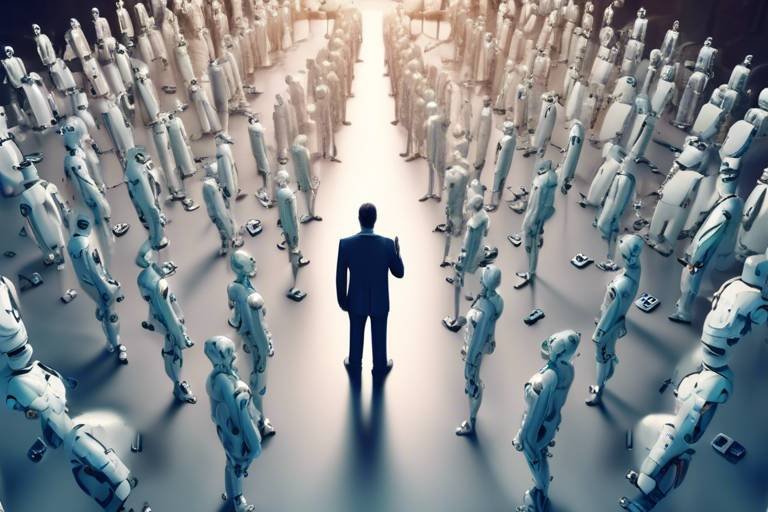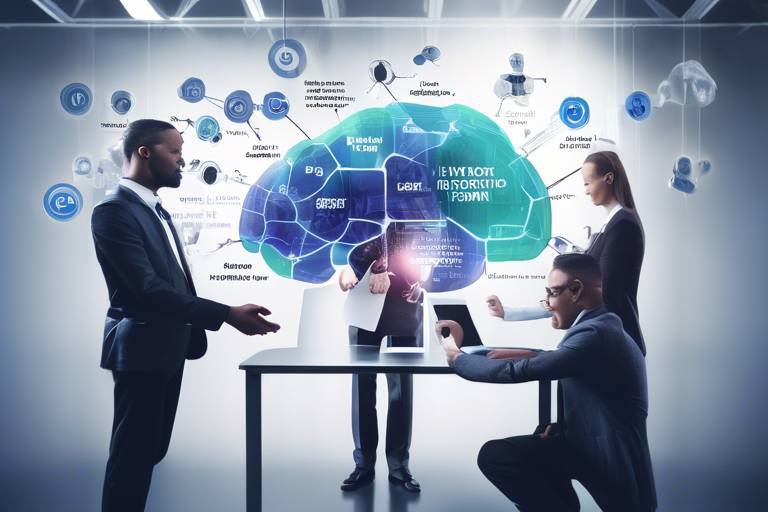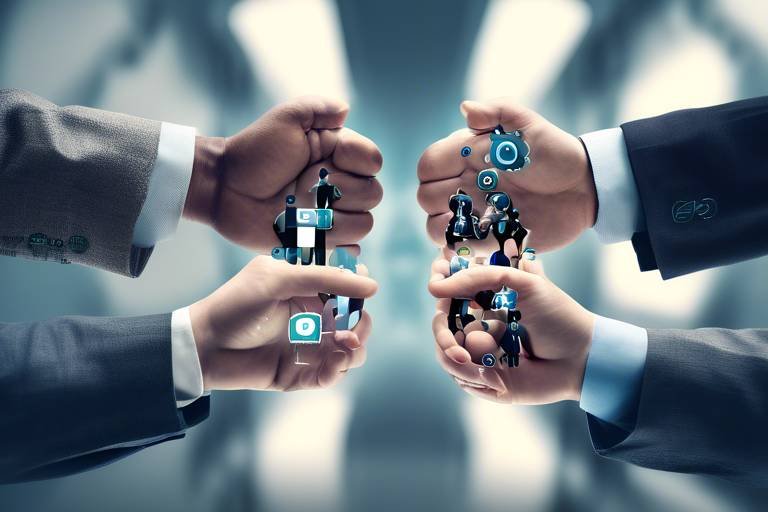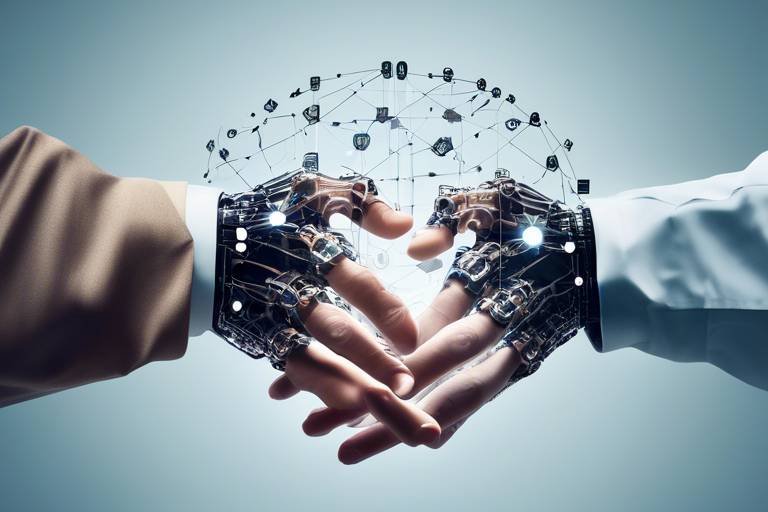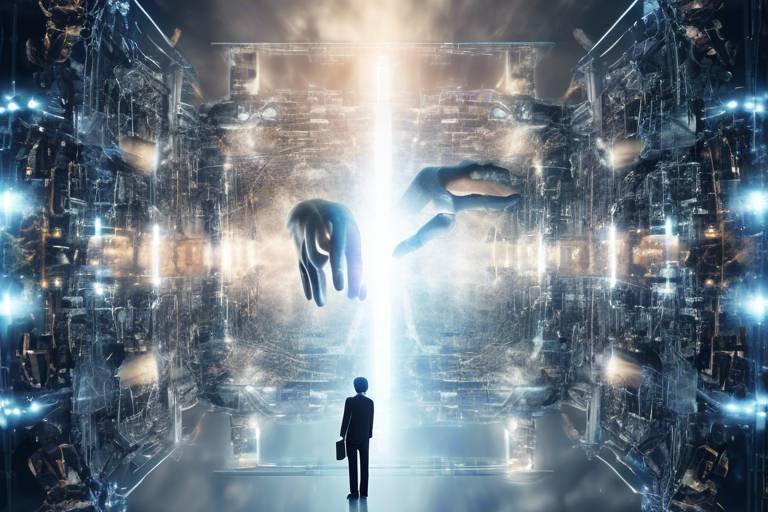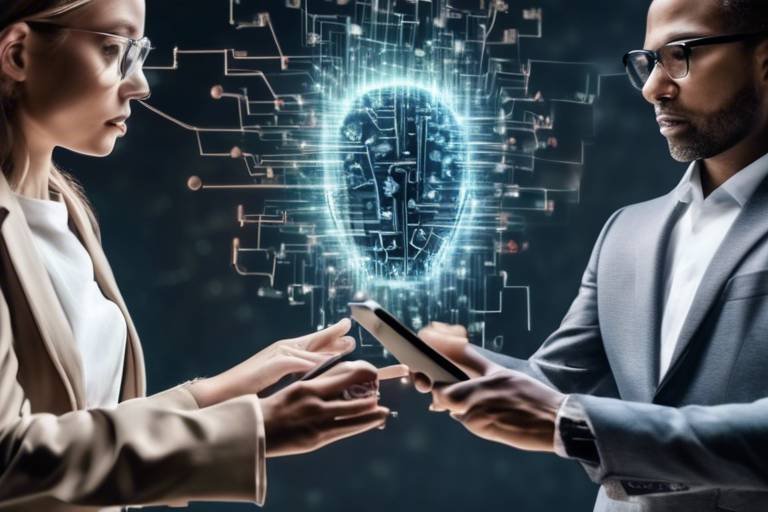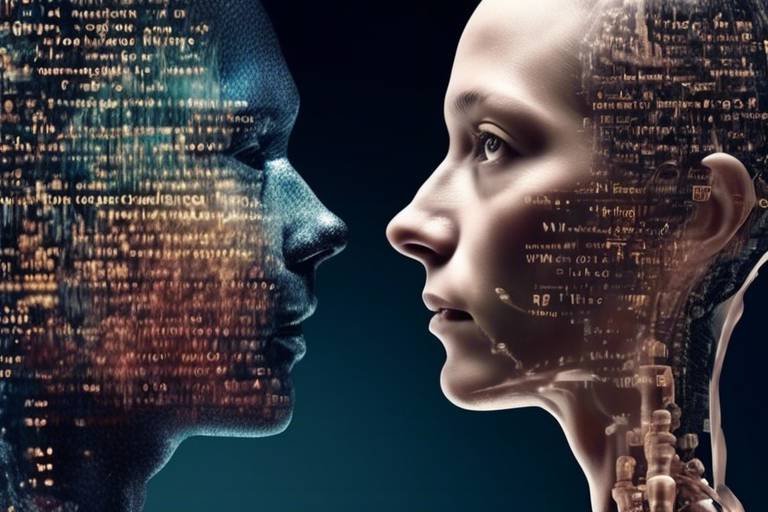AI and Human Collaboration: Mapping the Future
The relationship between artificial intelligence (AI) and human capabilities is evolving at an unprecedented pace, creating a landscape filled with both opportunities and challenges. As we stand on the brink of a technological revolution, it is essential to understand how AI can enhance our abilities while also recognizing the potential pitfalls that come with this integration. Imagine a world where machines not only assist us but also amplify our strengths, allowing us to achieve feats we once thought impossible. This collaboration is not just a futuristic dream; it is happening right now, reshaping industries and redefining the workforce.
AI's role in enhancing human capabilities cannot be overstated. From healthcare to education, AI tools are being implemented to streamline processes, improve accuracy, and ultimately lead to better outcomes. For instance, in healthcare, AI algorithms can analyze vast amounts of patient data to assist doctors in diagnosing diseases more accurately and quickly than ever before. In education, personalized learning platforms powered by AI adapt to the needs of individual students, making learning more engaging and effective. These examples illustrate how AI is not here to replace us but rather to work alongside us, enhancing our abilities and enabling us to focus on what truly matters.
However, as we embrace this technological advancement, we must also confront the challenges it presents. The integration of AI into our daily lives raises significant ethical concerns. Questions regarding privacy, bias in algorithms, and accountability for AI-driven decisions are at the forefront of this discussion. For example, if an AI system makes a biased decision regarding a loan application, who is responsible for that outcome? These ethical implications necessitate a careful examination of policies and practices to ensure that AI is used responsibly and fairly.
Moreover, the risk of job displacement looms large as AI technologies continue to advance. Many fear that machines will take over jobs, leaving humans without work. Yet, it’s essential to view this transformation through a different lens. While some jobs may indeed be at risk, new opportunities are emerging in fields that require human creativity, empathy, and critical thinking—qualities that AI cannot replicate. This shift highlights the need for workforce reskilling and adaptation to changing job landscapes. Organizations must invest in training programs to prepare their teams for the future, ensuring that employees are equipped with the skills necessary to thrive in an AI-enhanced world.
Looking ahead, the trends indicate that the collaboration between AI and humans will only deepen. Automation is transforming industries like manufacturing, logistics, and customer service, streamlining processes and enhancing productivity. In finance, AI tools provide data-driven insights that enable better decision-making, allowing professionals to make informed choices based on real-time analytics. This evolution signifies a future where AI acts as a partner, supporting us in our endeavors rather than competing against us.
As we navigate this exciting yet complex landscape, the importance of lifelong learning cannot be overstated. To remain relevant and effectively collaborate with AI, individuals must commit to continuous education and skill development. This means embracing a growth mindset—viewing challenges as opportunities for learning and growth. Organizations are already implementing upskilling and reskilling initiatives to prepare their workforce for the demands of AI-enhanced roles, fostering a culture of adaptability and innovation.
In conclusion, the future of AI and human collaboration is bright, filled with potential for enhanced capabilities and innovative solutions. However, it is crucial that we approach this partnership thoughtfully, addressing the ethical implications and preparing for the changes it brings to the workforce. By embracing lifelong learning and fostering a growth mindset, we can ensure that both humans and AI work together harmoniously, paving the way for a prosperous future.
- What is the role of AI in enhancing human capabilities?
AI serves as a powerful tool that enhances human abilities, enabling more efficient and effective task performance across various domains. - What are the ethical concerns surrounding AI integration?
Ethical concerns include privacy, bias, and accountability, which necessitate careful examination of policies and practices. - Will AI lead to job displacement?
While some jobs may be at risk, new opportunities are emerging that require human skills, highlighting the need for workforce reskilling. - How can individuals prepare for an AI-enhanced future?
Individuals should commit to lifelong learning and embrace a growth mindset to stay relevant in the changing job landscape.

The Role of AI in Enhancing Human Capabilities
Artificial intelligence (AI) is not just a buzzword; it's a game changer that is revolutionizing the way we live and work. Imagine having a super-smart assistant that can analyze vast amounts of data in the blink of an eye, offering insights that would take a human weeks to uncover. That's the power of AI! From healthcare to education, AI is enhancing human capabilities in ways that were once thought impossible. By automating repetitive tasks, AI frees up our time to focus on what truly matters—creativity, emotional intelligence, and complex problem-solving.
In the healthcare sector, for instance, AI algorithms can analyze medical images with remarkable accuracy, assisting doctors in diagnosing conditions like cancer at an early stage. This not only enhances the capabilities of healthcare professionals but also improves patient outcomes. Consider AI-powered tools that can predict patient deterioration by analyzing real-time data. This capability can save lives by enabling timely interventions.
Similarly, in education, AI is transforming learning experiences. Personalized learning platforms use AI to adapt to each student's unique needs, providing tailored resources that enhance understanding and retention. This means that students can learn at their own pace, receiving support where they need it most. The role of AI in education is not to replace teachers but to empower them, allowing educators to focus on fostering critical thinking and creativity among their students.
Moreover, AI is making waves in business environments as well. Companies are leveraging AI tools for data analysis, customer service, and even marketing strategies. Imagine a scenario where AI can predict customer preferences based on their past behavior, allowing businesses to tailor their offerings and improve customer satisfaction. This not only enhances operational efficiency but also drives growth in competitive markets.
However, the integration of AI into various sectors also raises questions about the future of work. As we embrace these advanced technologies, we must also consider how they complement human skills. The ideal scenario is one where AI acts as an extension of human capabilities, enhancing our strengths while compensating for our weaknesses. This collaboration can lead to unprecedented levels of productivity and innovation.
In conclusion, the role of AI in enhancing human capabilities is profound and multifaceted. As we continue to explore this partnership, we must remain mindful of the ethical implications and strive for a balance that maximizes benefits while minimizing risks. The future of work is not just about machines taking over; it's about humans and machines working together to achieve greater heights.

Challenges in AI and Human Collaboration
The integration of artificial intelligence (AI) into various sectors is not without its challenges. As we embrace this technological revolution, we must also confront significant hurdles that can impact the effectiveness of AI and human collaboration. One of the primary concerns is the ethical implications surrounding AI's use, including issues of privacy, bias, and accountability. These challenges require us to rethink how we design and implement AI systems, ensuring they align with human values and societal norms.
Moreover, as AI systems become more prevalent, there is a growing fear of job displacement. Many industries are automating tasks traditionally performed by humans, leading to concerns about the future of work. While AI has the potential to create new job opportunities, it also demands a workforce that is adaptable and equipped with new skills. This transition can be daunting for many, especially those who may not have the resources or support to reskill effectively.
In addition, effective communication between humans and machines poses another challenge. AI systems often operate on complex algorithms that can be difficult for the average person to understand. This complexity can lead to mistrust and misunderstanding, hindering the potential for successful collaboration. For instance, if a healthcare professional does not fully grasp how an AI tool generates its recommendations, they may be hesitant to rely on it, even if it is designed to enhance patient outcomes.
To address these challenges, it is essential to foster an environment that encourages open dialogue about the ethical use of AI. This includes:
- Developing clear guidelines for AI implementation.
- Investing in education to improve understanding of AI technologies.
- Promoting transparency in AI decision-making processes.
By tackling these challenges head-on, we can pave the way for a future where AI and humans work together harmoniously, maximizing the strengths of both parties. The journey may be complex and fraught with obstacles, but with a proactive approach, we can ensure that AI serves as a powerful ally rather than a competitor.
- What are the main challenges in AI and human collaboration?
The main challenges include ethical implications, job displacement, and effective communication between humans and machines.
- How can we address ethical concerns in AI?
We can address ethical concerns by developing clear guidelines, investing in education, and promoting transparency in AI systems.
- What is the impact of AI on jobs?
AI can lead to job displacement but also creates new opportunities, highlighting the need for workforce reskilling.

Ethical Implications of AI Integration
The integration of artificial intelligence into various sectors opens up a Pandora's box of ethical implications that society must navigate carefully. As AI systems become more autonomous and influential in decision-making processes, questions about privacy, bias, and accountability come to the forefront. For instance, when AI algorithms analyze personal data to make decisions, how do we ensure that individuals' privacy rights are respected? The challenge lies in balancing innovation with ethical standards, a task that requires collective effort from developers, policymakers, and society at large.
Moreover, the potential for bias in AI systems cannot be overlooked. These biases often stem from the data used to train AI models, which may reflect historical prejudices or societal inequalities. If not addressed, such biases can lead to unfair outcomes in critical areas such as hiring, law enforcement, and lending. This reality necessitates a proactive approach to understanding and mitigating bias, ensuring that AI serves as a tool for equity rather than a perpetuator of injustice.
Accountability is another significant concern in AI integration. When an AI system makes a decision that adversely affects an individual or group, who is held responsible? Is it the developer, the organization deploying the AI, or the AI itself? This ambiguity can create a legal and ethical quagmire. Therefore, establishing clear guidelines and frameworks is essential to ensure that human oversight remains integral to AI collaboration. This could involve creating a regulatory body dedicated to overseeing AI implementations, similar to how financial institutions are monitored.
In summary, while the integration of AI holds immense promise, it also raises critical ethical questions that must be addressed to foster a responsible and equitable future. It is imperative that as we advance technologically, we also cultivate a robust ethical framework that prioritizes human dignity and fairness. Only then can we harness the full potential of AI while safeguarding the rights and welfare of all individuals.
- What are the main ethical concerns regarding AI integration?
Key concerns include privacy, bias, and accountability in decision-making processes.
- How can we mitigate bias in AI systems?
By using diverse datasets for training and implementing rigorous testing protocols to identify and correct biases.
- Who is accountable for decisions made by AI systems?
Accountability can be complex, often involving developers, organizations, and legal frameworks that govern AI use.

Addressing Bias in AI Systems
Bias in artificial intelligence (AI) systems is a pressing issue that can significantly impact decision-making processes across various sectors. When we talk about bias, we're not just referring to a simple error; we're addressing a systemic problem that can lead to unfair outcomes, particularly for marginalized communities. Imagine a hiring algorithm that favors certain demographics over others, or a healthcare AI that misdiagnoses patients based on flawed data. These scenarios highlight the urgent need for a proactive approach to identify and mitigate bias in AI systems.
To tackle bias, organizations must start by understanding its origins. Bias can creep into AI systems through various channels, including:
- Data Bias: If the data used to train AI models is skewed or unrepresentative, the resulting algorithms will likely reflect those biases.
- Algorithmic Bias: Even with balanced data, the algorithms themselves can introduce bias based on how they are designed and implemented.
- Human Bias: Developers' unconscious biases can inadvertently influence the choices made during the design and training phases.
Addressing these biases requires a multi-faceted approach. Here are some strategies that can be employed:
- Data Audits: Regularly reviewing and auditing datasets to ensure they are diverse and representative of the population.
- Algorithm Transparency: Making algorithms more transparent allows for better scrutiny and understanding of how decisions are made.
- Diverse Teams: Encouraging diversity within development teams can help bring different perspectives to the table, ultimately leading to more equitable AI solutions.
Moreover, it’s essential to implement guidelines and frameworks that hold organizations accountable for the outcomes of their AI systems. By establishing clear protocols for testing and validating AI models, we can create a more responsible and ethical AI landscape. This not only helps in addressing bias but also fosters public trust in AI technologies.
In summary, addressing bias in AI systems is not just a technical challenge; it’s a societal responsibility. By prioritizing fairness and equity in AI development, we can harness the full potential of these technologies while ensuring they serve the best interests of all individuals, regardless of their background.
- What is AI bias? AI bias refers to systematic and unfair discrimination in AI systems that can arise from flawed data, algorithms, or human influence.
- How can bias in AI systems be mitigated? Bias can be mitigated through data audits, algorithm transparency, and fostering diverse development teams.
- Why is addressing AI bias important? Addressing AI bias is crucial to ensure fair and equitable outcomes, particularly for marginalized communities, and to build public trust in AI technologies.

Accountability in AI Decision-Making
In the rapidly evolving landscape of artificial intelligence (AI), the question of accountability in AI decision-making has become increasingly critical. As AI systems take on more responsibilities, from driving cars to making medical diagnoses, determining who is responsible for their decisions is a complex challenge. This issue is not just a technical one; it involves legal, ethical, and social dimensions that require careful consideration.
At the heart of the accountability debate lies the question: Who is responsible when an AI system makes a mistake? Is it the developers who created the algorithm, the organizations that deployed it, or the users who relied on its outputs? This ambiguity can lead to significant consequences, particularly when AI systems are involved in high-stakes situations, such as criminal justice or healthcare.
To address these concerns, several key factors must be considered:
- Transparency: AI systems should be designed to be transparent, allowing stakeholders to understand how decisions are made. This means providing clear documentation on the algorithms used and the data that informs them.
- Human Oversight: Maintaining a level of human oversight is essential. Even as AI systems become more autonomous, having humans in the loop ensures that critical decisions are vetted by individuals who can assess the context and implications.
- Clear Guidelines: Establishing clear guidelines and frameworks for accountability is vital. These guidelines should outline the roles and responsibilities of all parties involved in the AI development and deployment process.
Moreover, organizations must foster a culture of accountability that encourages ethical AI practices. This can involve implementing training programs for employees on the ethical implications of AI and establishing a system for reporting and addressing issues that arise from AI decisions.
As we navigate this complex terrain, it becomes evident that accountability in AI decision-making is not merely a technical issue; it is a societal challenge that requires collaboration among technologists, ethicists, policymakers, and the general public. By working together, we can create a framework that not only holds AI systems accountable but also ensures that they serve humanity's best interests.
- What is accountability in AI? Accountability in AI refers to the responsibility that individuals or organizations have for the decisions made by AI systems, especially when those decisions impact people's lives.
- Why is human oversight important in AI? Human oversight is crucial because it ensures that AI systems are checked for accuracy and ethical considerations, helping to prevent errors that could have serious consequences.
- How can organizations promote accountability in AI? Organizations can promote accountability by establishing clear guidelines, ensuring transparency in AI processes, and fostering a culture of ethical AI practices among their employees.

Job Displacement and Workforce Transformation
The rapid advancement of artificial intelligence (AI) technologies has sparked a whirlwind of discussions around job displacement and workforce transformation. As machines become increasingly capable of performing tasks that were once the sole domain of humans, many people are understandably concerned about their job security. However, while it's true that certain roles may become obsolete, it's crucial to recognize that this shift also presents a unique opportunity for growth and innovation.
Historically, technological advancements have always prompted fears of job loss. Think about the industrial revolution: while it displaced many skilled artisans, it also created an array of new jobs in factories and new industries. Similarly, AI is poised to transform the job landscape, but rather than merely replacing jobs, it is likely to redefine them. For instance, AI can take over repetitive and mundane tasks, allowing human workers to focus on more complex, creative, and strategic aspects of their roles. This shift not only enhances productivity but also leads to more fulfilling work experiences.
Moreover, the integration of AI into various sectors is giving rise to entirely new job categories that didn't exist before. Roles such as AI trainers, data analysts, and AI ethics compliance officers are becoming increasingly vital. According to a recent study, it's estimated that by 2030, AI could create around 133 million new roles globally, outpacing the 75 million jobs that might be displaced. This highlights the importance of being proactive about reskilling and upskilling the workforce.
To effectively navigate this transition, organizations must embrace a culture of continuous learning. This means investing in training programs that equip employees with the skills needed to thrive in an AI-enhanced environment. For example, companies can offer workshops on data literacy, machine learning basics, and even soft skills like adaptability and problem-solving. By fostering an adaptable workforce, businesses can not only mitigate the risks of job displacement but also harness the full potential of AI.
In essence, while the fear of job loss due to AI is valid, it's essential to view this transformation through a lens of opportunity. The collaboration between humans and AI can lead to a more dynamic and innovative workforce. By preparing for the changes ahead, both employees and organizations can ensure that they are not left behind in this exciting new era of work.
- Will AI really replace my job? While some jobs may be automated, many roles will evolve, and new jobs will be created as a result of AI integration.
- What can I do to prepare for changes in my job? Embrace lifelong learning and consider upskilling or reskilling in areas that complement AI technologies.
- How can organizations support their employees during this transition? Companies can implement training programs and foster a culture of adaptability to help employees navigate the changes brought by AI.
- What new job opportunities are emerging due to AI? Roles such as AI trainers, data analysts, and AI ethics compliance officers are becoming increasingly important in the workforce.

Future Trends in AI and Human Collaboration
The future of AI and human collaboration is not just a distant concept; it’s unfolding right before our eyes, shaping the way we work, live, and interact. As we dive into this exciting realm, we can anticipate several key trends that will redefine our relationship with technology. Increased automation will be at the forefront, streamlining tasks across various sectors, from manufacturing to healthcare. Imagine a world where mundane tasks are handled by machines, allowing humans to focus on more creative and strategic endeavors. This shift not only boosts productivity but also enhances job satisfaction, as individuals engage in work that truly matters.
Moreover, the integration of AI into decision-making processes is set to revolutionize how we approach challenges. AI systems can analyze vast amounts of data in seconds, providing insights that humans might overlook. For instance, in fields like finance and healthcare, AI can identify patterns and predict outcomes, enabling professionals to make informed decisions with confidence. This collaborative approach means that while AI offers data-driven support, human intuition and experience remain invaluable.
As we look further into the future, we can expect the emergence of entirely new job categories that bridge the gap between AI and human skills. Roles such as AI trainers, data ethicists, and human-AI interaction specialists are likely to become mainstream. These positions will require a unique blend of technical know-how and interpersonal skills, emphasizing the importance of adaptability in the workforce. To illustrate this point, consider the following table showcasing potential job roles that might arise:
| Job Role | Description | Skills Required |
|---|---|---|
| AI Trainer | Responsible for training AI systems to improve their accuracy and efficiency. | Data analysis, programming, and communication skills. |
| Data Ethicist | Ensures AI systems are used ethically, focusing on privacy and fairness. | Ethics, law, and data management knowledge. |
| Human-AI Interaction Specialist | Focuses on improving the interaction between humans and AI systems. | UX design, psychology, and technical skills. |
In addition to these changes, the importance of lifelong learning cannot be overstated. As the landscape of work continuously evolves, individuals will need to commit to ongoing education and skill development. Embracing a growth mindset will be crucial, allowing people to adapt to new technologies and methodologies. By viewing challenges as opportunities for growth, individuals can navigate the complexities of AI collaboration with confidence.
Ultimately, the future of AI and human collaboration is not just about machines replacing humans; it’s about enhancing our capabilities and creating a synergistic relationship where both can thrive. As we embrace these trends, we must also remain vigilant about the ethical implications and ensure that our integration of AI is responsible and equitable.
- What are the main benefits of AI and human collaboration? AI enhances human capabilities, increases efficiency, and allows individuals to focus on strategic tasks.
- Will AI take away jobs? While some jobs may be displaced, new roles will emerge, highlighting the need for reskilling and adaptation.
- How can individuals prepare for the future of work with AI? Embracing lifelong learning and developing a growth mindset are essential for adapting to changes.

Automation in Various Industries
Automation, powered by artificial intelligence, is revolutionizing various industries by enhancing efficiency and productivity. From manufacturing to healthcare, the impact of AI-driven automation is profound and far-reaching. In manufacturing, for instance, robots are now capable of performing repetitive tasks with precision, reducing human error and increasing output. This shift not only accelerates production timelines but also allows human workers to focus on more complex and creative tasks that require critical thinking and problem-solving skills.
In the realm of logistics, AI is optimizing supply chain management by predicting demand, managing inventory, and even automating warehousing operations. For example, companies are using AI algorithms to analyze historical data and forecast future trends, which helps in making informed decisions about stock levels and delivery schedules. This not only saves time but also minimizes costs associated with overstocking or stockouts.
Moreover, the customer service sector is witnessing a significant transformation due to automation. Chatbots and virtual assistants powered by AI are handling customer inquiries 24/7, providing instant responses and freeing up human agents to tackle more complex issues. This not only enhances customer satisfaction but also improves operational efficiency, allowing businesses to serve more clients without a proportional increase in staffing costs.
However, while automation brings numerous benefits, it also necessitates a shift in workforce skills. As industries embrace AI technologies, there is a growing demand for professionals who can manage and maintain these systems. This creates a unique opportunity for individuals to upskill and adapt to the evolving job market. Organizations are recognizing this need and are increasingly investing in training programs to equip their employees with the necessary skills to thrive in an automated environment.
In summary, automation is not merely a trend; it is a fundamental shift that is reshaping the landscape of various industries. As we move forward, the collaboration between humans and AI will continue to evolve, fostering a dynamic work environment where efficiency and creativity can coexist. Embracing this change is crucial for both businesses and employees alike to remain competitive in an increasingly automated world.

Enhancing Decision-Making Through AI
In today's fast-paced world, the ability to make quick and informed decisions can be the difference between success and failure. This is where artificial intelligence (AI) steps in, revolutionizing the way we approach decision-making across various sectors. Imagine having a supercharged assistant that can analyze vast amounts of data in seconds, offering insights that would take a human hours, if not days, to uncover. That's the power of AI!
AI tools are increasingly being integrated into critical areas such as finance, healthcare, and strategic planning. For instance, in finance, AI algorithms can predict market trends by analyzing historical data and current events, allowing investment firms to make data-driven decisions that maximize returns. In healthcare, AI can assist doctors by analyzing patient data and suggesting potential diagnoses or treatment plans, thereby enhancing patient outcomes. This collaboration between humans and AI not only improves efficiency but also ensures that decisions are based on comprehensive and accurate data.
Moreover, the use of AI in decision-making processes can be categorized into several key areas:
- Data Analysis: AI excels at processing and analyzing large datasets, uncovering patterns that humans might miss.
- Predictive Analytics: By utilizing historical data, AI can forecast future events, helping organizations to strategize effectively.
- Risk Assessment: AI can evaluate risks in real-time, providing insights that lead to more informed decision-making.
However, while AI enhances decision-making capabilities, it is crucial to remember that it should complement human judgment rather than replace it. The human touch—intuition, ethics, and emotional intelligence—plays an irreplaceable role in many decisions, particularly those involving complex social dynamics or moral considerations. For example, in healthcare, while AI can suggest treatments based on data, the final decision often requires a compassionate understanding of the patient's unique situation.
As we continue to integrate AI into our decision-making frameworks, organizations must also invest in training their workforce to effectively utilize these tools. This training should focus on interpreting AI-generated insights and understanding the limitations of AI systems. After all, the goal is to create a synergistic relationship where AI enhances human capabilities, enabling better and more informed decisions.
In conclusion, the collaboration between AI and human decision-making is not just a trend; it is a transformative shift that promises to redefine how we approach challenges in various fields. By embracing these technologies and fostering a culture of adaptability, we can harness the full potential of AI to make smarter, more effective decisions that drive progress and innovation.
- How does AI improve decision-making?
AI improves decision-making by analyzing large datasets quickly and providing insights that humans can use to make informed choices. - Can AI replace human decision-making?
No, AI should complement human decision-making by providing data-driven insights, but it cannot replace the human touch in complex situations. - What industries benefit the most from AI-enhanced decision-making?
Industries such as finance, healthcare, and logistics greatly benefit from AI-enhanced decision-making due to the complexity and volume of data they handle.

The Importance of Lifelong Learning
Lifelong learning is not just a buzzword; it’s a necessity in today’s fast-paced world. With technology evolving at breakneck speed, especially in the realm of artificial intelligence, the need to continuously acquire new skills and knowledge has become more important than ever. Imagine trying to navigate a rapidly changing landscape without a map—this is what it feels like for those who resist the idea of lifelong learning. It’s like being a ship in a storm without a compass, lost and vulnerable.
As AI continues to integrate into various sectors, individuals must adapt to stay relevant. This means embracing a mindset of continuous education and skill development. Whether it’s taking online courses, attending workshops, or simply engaging in self-study, the opportunities for learning are abundant. Think of lifelong learning as a garden; the more you nurture it with new information, the more it blossoms into a rich landscape of skills and experiences.
Moreover, organizations are recognizing the importance of fostering a culture of lifelong learning. Companies are increasingly investing in upskilling and reskilling initiatives to prepare their workforce for the demands of AI-enhanced roles. This not only benefits employees by enhancing their career prospects but also positions companies to remain competitive in an ever-evolving market. The table below illustrates some key initiatives that organizations can implement to promote lifelong learning:
| Initiative | Description |
|---|---|
| Online Training Programs | Flexible courses that employees can take at their own pace, covering relevant skills. |
| Mentorship Opportunities | Pairing less experienced employees with seasoned professionals to share knowledge and insights. |
| Workshops and Seminars | Interactive sessions that focus on specific skills or topics, encouraging hands-on learning. |
| Cross-Departmental Projects | Encouraging collaboration between departments to foster a diverse learning environment. |
Adopting a growth mindset is also crucial in this journey. When individuals view challenges as opportunities rather than obstacles, they open themselves up to a world of possibilities. It’s about embracing the idea that learning doesn’t stop after formal education; it’s a lifelong adventure. Just like a musician who practices daily to master their craft, professionals must also commit to honing their skills consistently.
In conclusion, the importance of lifelong learning cannot be overstated. As AI continues to shape our future, the ability to adapt and grow will be the key to success. By investing in personal development and fostering a culture of continuous learning, individuals and organizations alike can thrive in an increasingly automated world. So, are you ready to embark on your lifelong learning journey?
- What is lifelong learning? Lifelong learning refers to the ongoing, voluntary, and self-motivated pursuit of knowledge for personal or professional development.
- Why is lifelong learning important? It helps individuals adapt to changing job requirements, enhances career prospects, and fosters personal growth.
- How can I engage in lifelong learning? You can participate in online courses, attend workshops, read books, or seek mentorship opportunities.
- What are the benefits of a growth mindset? A growth mindset encourages resilience, adaptability, and a willingness to learn from failures, leading to greater success in personal and professional endeavors.

Upskilling and Reskilling Initiatives
In today’s rapidly evolving job market, the importance of upskilling and reskilling cannot be overstated. As artificial intelligence continues to transform industries, workers find themselves needing to adapt to new technologies and methodologies. Upskilling refers to the process of enhancing existing skills, while reskilling involves training individuals in new skills that may be entirely different from their current expertise. Organizations are recognizing that investing in their workforce is not just beneficial for employees but is crucial for maintaining a competitive edge in the market.
Many companies are implementing comprehensive training programs that focus on both upskilling and reskilling. These initiatives often include workshops, online courses, and mentorship opportunities that allow employees to learn at their own pace. For instance, a company might offer data analytics courses to employees in marketing roles, enabling them to leverage AI tools for better decision-making. By fostering an environment of continuous learning, organizations can ensure their teams remain agile and innovative.
Moreover, the rise of digital platforms has made it easier than ever for employees to access training resources. Many organizations partner with online learning platforms to provide employees with a wealth of courses tailored to their specific needs. This flexibility allows workers to balance their learning with their day-to-day responsibilities, making it easier to integrate new skills into their work routines.
To illustrate the impact of these initiatives, consider the following table that outlines the benefits of upskilling and reskilling for both employees and organizations:
| Benefits | For Employees | For Organizations |
|---|---|---|
| Enhanced Skill Sets | Improved job performance and career advancement | Increased productivity and innovation |
| Job Security | Greater adaptability to changing job roles | Reduced turnover and associated costs |
| Personal Growth | Boosted confidence and job satisfaction | Stronger company culture and employee engagement |
In addition to formal training programs, organizations are also encouraging a culture of peer learning. This can involve collaborative projects where employees share knowledge and skills with each other. For example, a software developer might mentor a colleague from a different department on coding practices, fostering an environment of mutual growth. This not only enhances skills but also builds camaraderie and teamwork within the organization.
As we move further into the age of AI, it’s clear that upskilling and reskilling are not just trends—they are necessities. Workers who embrace lifelong learning will find themselves better equipped to navigate the complexities of their roles, while organizations that prioritize these initiatives will likely see a more skilled, motivated, and adaptable workforce. It's a win-win scenario that promotes growth on both sides of the equation.
- What is the difference between upskilling and reskilling?
Upskilling involves enhancing existing skills, while reskilling focuses on training individuals for entirely new roles. - Why are upskilling and reskilling important?
They help employees adapt to technological changes and ensure organizations remain competitive in a rapidly evolving job market. - How can organizations implement effective upskilling and reskilling programs?
By offering a mix of formal training, online courses, and fostering a culture of peer learning.

Embracing a Growth Mindset
In today's rapidly changing world, embracing a growth mindset has become more than just a personal development trend; it's a necessity for thriving in an era dominated by artificial intelligence. A growth mindset, as popularized by psychologist Carol Dweck, is the belief that abilities and intelligence can be developed through dedication and hard work. This perspective is crucial when collaborating with AI, as it encourages individuals to view challenges as opportunities for growth rather than insurmountable obstacles.
Imagine a world where every setback is seen as a stepping stone rather than a stumbling block. This is the essence of a growth mindset. It fosters resilience, adaptability, and a willingness to learn—qualities that are essential when navigating the complexities of AI integration in the workplace. For instance, when faced with the prospect of learning new technologies or adapting to automated processes, individuals with a growth mindset are more likely to embrace the challenge, seeking out resources, training, and mentorship to enhance their skills.
Moreover, a growth mindset promotes a culture of continuous improvement within organizations. Companies that encourage their employees to adopt this mindset often experience higher levels of innovation and collaboration. When team members are not afraid to fail, they are more likely to experiment with new ideas and approaches, leading to breakthroughs that can significantly benefit the organization. This is particularly important in fields like technology and healthcare, where AI is transforming processes and outcomes.
To cultivate a growth mindset, individuals can take several practical steps:
- Seek Feedback: Actively request feedback from peers and supervisors to identify areas for improvement.
- Set Learning Goals: Establish specific, measurable goals that focus on skill development and knowledge acquisition.
- Embrace Challenges: View challenges as opportunities to learn rather than threats to competence.
- Reflect on Experiences: Regularly reflect on successes and failures to extract valuable lessons.
By implementing these strategies, individuals not only enhance their own capabilities but also contribute to a more dynamic and innovative workplace. The synergy between a growth mindset and AI collaboration can lead to remarkable advancements, as both humans and machines learn from each other in a symbiotic relationship.
In conclusion, embracing a growth mindset is not just about personal development; it is about preparing for a future where collaboration with AI is the norm. By fostering a culture of learning and adaptability, individuals and organizations can not only survive but thrive in an ever-evolving landscape. As we move forward, let’s remember that the key to unlocking our potential lies in our willingness to learn, adapt, and embrace the unknown.
- What is a growth mindset? A growth mindset is the belief that abilities and intelligence can be developed through dedication and hard work.
- How can I develop a growth mindset? You can develop a growth mindset by seeking feedback, setting learning goals, embracing challenges, and reflecting on your experiences.
- Why is a growth mindset important in AI collaboration? A growth mindset encourages adaptability and resilience, which are essential for effectively working alongside AI technologies.
- Can organizations benefit from a growth mindset? Yes, organizations that promote a growth mindset often see increased innovation, collaboration, and overall performance.
Frequently Asked Questions
- What is the role of AI in enhancing human capabilities?
AI acts as a powerful ally for humans, helping us perform tasks more efficiently. Whether in healthcare, education, or any other field, it empowers individuals by providing tools that streamline processes and improve decision-making.
- What are the main challenges in AI and human collaboration?
While AI offers numerous benefits, challenges such as ethical concerns, job displacement, and the need for effective communication between humans and machines arise. It's crucial to address these issues to ensure a harmonious integration.
- How does bias affect AI systems?
Bias in AI can lead to unfair outcomes, particularly in decision-making processes. It's essential to understand and mitigate these biases to ensure that AI systems collaborate equitably with humans, promoting fairness and justice.
- What are the implications of job displacement due to AI?
As AI technologies advance, some jobs may be at risk of being displaced. However, this also opens doors to new opportunities, emphasizing the need for workforce reskilling and adaptation to the evolving job landscape.
- What trends can we expect in AI and human collaboration in the future?
Looking ahead, we can expect increased automation, enhanced decision-making capabilities, and the emergence of new job categories. The collaboration between AI and humans will continue to evolve, shaping the future of work.
- Why is lifelong learning important in the context of AI?
Lifelong learning is vital as the work landscape changes due to AI. Continuous education and skill development ensure individuals remain relevant and can effectively collaborate with AI technologies.
- What initiatives are organizations taking to prepare their workforce for AI?
Organizations are implementing upskilling and reskilling programs to help employees adapt to AI-enhanced roles. This fosters a culture of adaptability and growth, ensuring that the workforce is equipped for the future.
- How can individuals embrace a growth mindset in the age of AI?
Adopting a growth mindset means viewing challenges as opportunities for learning. This attitude is essential for navigating the complexities of AI collaboration, allowing individuals to thrive in a rapidly changing environment.

